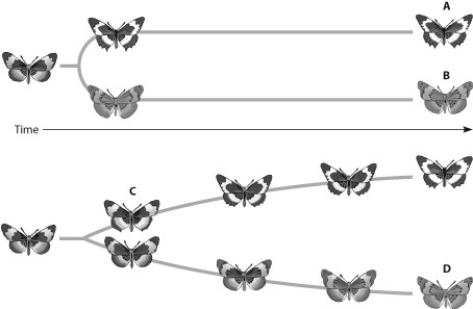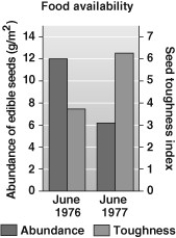A) there is no disruption in gene flow between two populations.
B) a geographic barrier forms between two populations.
C) several populations become isolated from one another as drying conditions cause a large body of water to become separate, smaller bodies of water.
D) separated populations adapt to different environmental conditions.
F) A) and C)
Correct Answer

verified
Correct Answer
verified
Multiple Choice
Which of the following would tend to promote adaptive radiation?
A) An organism has a very stable set of features and capabilities over long spans of evolutionary time.
B) An organism colonizes an isolated area that is habitable but relatively devoid of life.
C) An organism colonizes an area that already has a high level of existing species diversity.
D) A single species goes extinct, but it has several competitors that quickly expand to assume its ecological roles.
F) B) and D)
Correct Answer

verified
Correct Answer
verified
Multiple Choice
If H. floresiensis were reunited with H. erectus at a much later date but the two populations could no longer interbreed, it would be correct to conclude that
A) H. floresiensis is no longer fertile as a species.
B) the two groups had been isolated for more than 50,000 years.
C) H. floresiensis has become less fit than H. erectus.
D) a reproductive barrier had evolved.
F) A) and B)
Correct Answer

verified
Correct Answer
verified
Multiple Choice
Which of the following types of reproductive barriers separates a pair of species that could interbreed but for the fact that one mates at dusk and the other at dawn?
A) temporal isolation
B) habitat isolation
C) behavioral isolation
D) mechanical isolation
F) B) and D)
Correct Answer

verified
Correct Answer
verified
Multiple Choice
Organisms that possess more than two complete sets of chromosomes are said to be
A) haploid.
B) polyploid.
C) diploid.
D) hybrids.
F) A) and C)
Correct Answer

verified
B
Correct Answer
verified
Multiple Choice
A new plant species may arise in a single generation by
A) errors in meiosis leading to polyploidy.
B) a sudden geological disruption causing separation of two populations.
C) mutations in genes for flower color.
D) changes in the pollinator species.
F) None of the above
Correct Answer

verified
Correct Answer
verified
Multiple Choice
Diane Dodd's experiments using fruit flies demonstrated that
A) the evolution of reproductive barriers occurs much too slowly to produce measurable effects in the laboratory.
B) new species can form in a single generation by the production of new reproductive structures.
C) formation of a reproductive barrier between two populations is more likely if they experience and adapt to different environmental conditions.
D) reproductive barriers usually are absolute: Either two populations are fully willing and able to interbreed, or they are strictly separated by a fully effective reproductive barrier.
F) A) and C)
Correct Answer

verified
Correct Answer
verified
Multiple Choice
A group of ants escaped from a picnic basket carried to the top of a mountain and thrived in this area where there were no other ants. Many years later descendants of these ants crawled into a picnic basket on the mountain and traveled back to the valley from which their ancestors had come. Which of these observations would cause you to conclude that the ants on top of the mountain had become a different species from those in the valley?
A) The mountain ants and valley ants were different colors.
B) The mountain ants and valley ants were different sizes.
C) The mountain ants ate different food than the valley ants.
D) The mountain ants could not mate with the valley ants.
F) C) and D)
Correct Answer

verified
Correct Answer
verified
Multiple Choice
One of the finest available sequences of fossils shows how horses have changed slowly and by subtle steps from small, shrub-browsing ancestors to the large, grass-grazing modern horse. A large number of fossil species have been named, and it is often difficult to decide on the identity of a fossil horse because transitional forms are common. This record of evolution best fits the idea of
A) the gradual model of speciation.
B) punctuated equilibrium.
C) adaptive radiation.
D) hybrid breakdown.
F) A) and B)
Correct Answer

verified
Correct Answer
verified
Multiple Choice
Under the biological species concept, a species is a group of organisms that
A) are physically similar.
B) share a recent common ancestor.
C) live together in a location and carry out identical ecological roles.
D) have the potential to interbreed in nature and produce fertile offspring.
F) All of the above
Correct Answer

verified
Correct Answer
verified
Multiple Choice
Which of the following types of reproductive barriers separates two flowering plant species that could interbreed but for the fact that one has a deep flower tube and is pollinated by bumblebees whereas the other has a short, narrow flower tube and is pollinated by honeybees?
A) habitat isolation
B) behavioral isolation
C) mechanical isolation
D) gametic isolation
F) A) and D)
Correct Answer

verified
Correct Answer
verified
Multiple Choice
Which butterfly has changed gradually but significantly from its ancestor through microevolutionary events that were not part of a speciation event? 
A) butterfly A
B) butterfly B
C) butterfly C
D) butterfly D
F) None of the above
Correct Answer

verified
Correct Answer
verified
Multiple Choice
The Monterey pine and the Bishop's pine inhabit some of the same areas of central California. The Monterey pine releases pollen in February, while the Bishop's pine does so in April. This is an example of ________ isolation.
A) postzygotic
B) temporal
C) habitat
D) mechanical
F) None of the above
Correct Answer

verified
Correct Answer
verified
Multiple Choice
Which of the following descriptions best represents the gradual model of speciation?
A) Speciation occurs regularly as a result of the accumulation of many small changes.
B) An isolated population differentiates quickly from its parent stock as it adapts to its local environment.
C) Speciation occurs under unusual circumstances and therefore transitional fossils are hard to find.
D) Species undergo little change over long periods interrupted only by short periods of rapid change.
F) C) and D)
Correct Answer

verified
Correct Answer
verified
Multiple Choice
Two species that occasionally mate and produce zygotes, but that have incompatible genes that prevent the resulting embryo from developing, are affected by
A) gametic isolation.
B) reduced hybrid fertility.
C) reduced hybrid viability.
D) behavioral isolation.
F) A) and B)
Correct Answer

verified
C
Correct Answer
verified
Multiple Choice
When a tetraploid flower pollinates a diploid flower of the parental species, the resulting offspring will be
A) pentaploid and sterile.
B) diploid and fertile.
C) triploid and fertile.
D) triploid and sterile.
F) A) and C)
Correct Answer

verified
Correct Answer
verified
Multiple Choice
Which of the following would a biologist describe as microevolution?
A) the formation of new species
B) the extinction of species
C) dramatic biological changes, such as the origin of flight, within a taxon
D) a change in the gene pool of a population from one generation to the next
F) A) and B)
Correct Answer

verified
Correct Answer
verified
Multiple Choice
Uplift and formation of a mountain range divide a freshwater snail species into two isolated populations. Erosion eventually lowers the mountain range and brings the two populations together again, but when they mate, the resulting hybrids all produce sterile young. This scenario is an example of
A) sympatric speciation.
B) allopatric speciation.
C) incomplete speciation.
D) diversifying speciation.
F) A) and B)
Correct Answer

verified
B
Correct Answer
verified
Multiple Choice
The data in this graph indicate 
A) there were fewer total tough seeds in 1976 than in 1977.
B) plants that produced soft seeds in 1976 produced tougher seeds in 1977.
C) available seeds were generally tougher in 1977 than in 1976.
D) seed abundance in 1977 was severely reduced by finch feeding.
F) C) and D)
Correct Answer

verified
Correct Answer
verified
Multiple Choice
In the chiclid populations in Lake Victoria, what trait in females acted as a selection factor on which males they mated with?
A) color vision
B) body color
C) preferred water depth
D) ability to hear sounds made by the male
F) B) and D)
Correct Answer

verified
Correct Answer
verified
Showing 1 - 20 of 59
Related Exams